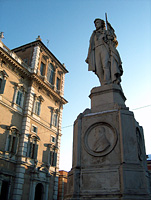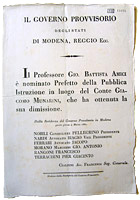A biography of Giovanni Battista Amici
1824-1827 - The first trip to Paris and to London: London -  return to index
return to index
On 5 June they left Paris in the l’Hirondelle stagecoach. The evening of the 6th they stayed at the Hôtel de Rignolle in Calais and the next morning they boarded the English vapour ferry Lord Melville. Preceded as he was by his fame as a skilful instrument maker, Amici found as enthusiastic a welcome in the English capital as he had in Paris. He encountered J.F.W. Herschel first, who had come to visit Amici in Modena in April 1824. On 26 September of that year, Amici wrote to Giovanni Plana “It seems that Mr. Herschel is very satisfied by my instruments. He carries one of my Distance Measurers with him around London and as soon as possible I will send him one of my large micrometers for a seven-foot achromatic telescope which he wishes to use to measure double stars.”
When Joseph Fraunhofer (1787-1826) revealed his great refractor telescope, constructed for Dorpat, to the scientific world on 10 July, 1824 some were lead to the “erroneous impression” that reflector telescopes were by now relegated to certain inferiority. Herschel wrote a letter from Slough dated 15 August, 1825 to the editor of the “Astronomische Nachrichten” in which he says that “Those who have witnessed the performance of M. Amici’s beautiful Newtonian reflectors, will not readily admit this inferiority”.
 In London, besides Herschel, Amici met with the Rev. Hussey, the Italian Physicist Ottaviano Fabrizio Mossotti, exiled and waiting to board a ship for Argentina, the Rev. William Pearson, vice president and treasurer of the Royal Astronomical Society who described Amici’s micrometer in his Introduction to Practical Astronomy published two years later, and the optician Joseph Jackson Lister with whom Amici compared the results obtained by Dr Goring, by Tulley and by Dollond in perfecting the microscope. Lister would remember the contribution of Amici in his important article published in 1830: On some properties in achromatic object-glasses applicable to the improvement of the microscope.
In London, besides Herschel, Amici met with the Rev. Hussey, the Italian Physicist Ottaviano Fabrizio Mossotti, exiled and waiting to board a ship for Argentina, the Rev. William Pearson, vice president and treasurer of the Royal Astronomical Society who described Amici’s micrometer in his Introduction to Practical Astronomy published two years later, and the optician Joseph Jackson Lister with whom Amici compared the results obtained by Dr Goring, by Tulley and by Dollond in perfecting the microscope. Lister would remember the contribution of Amici in his important article published in 1830: On some properties in achromatic object-glasses applicable to the improvement of the microscope.
Vincenzo wrote in his diary:
Amici met Captain Henry Kater (1777-1835), mathematician and man of science, who had recently described a collimator. From this Amici had come up with the idea of a float over the mercury furnished with a small telescope (Descrizione di un nuovo Istrumento per livellare – Description of a New Instrument for Levelling). He met the physicist William Henry Fox Talbot, whom he had already met in Modena in 1822. Talbot would soon become a pioneer in photography.11. June. Mr. Tulley father and son, Dr. Pearson, Mossotti, Lister who is a Quaker who knows a lot about microscopes, Keir, a Scottish engineer and others came to visit us today. We then went to Mr. Lister’s house; he compared our microscope to his composed by two achromatic lenses, one by Tulley and one by Chevalier. It has no combination equal in strength and clarity to our objectives with two lens. But he has a simple achromatic objective from Tulley made of three glasses and that is perfect. It has an inch of focal length and can enlarge nearly as much as the fourth eyepiece in the catadioptric microscope by lengthening the tube.
16. A great number of people came to see the Microscope this morning: Vivian, Gill, Talbot, Capt. Sabine, Capt. Chapman, Couthbert, Coope the chemist, Jonas, etc. Talbot brought Chevalier’s microscope and he was finally persuaded that it is quite inferior to Papa’s reflecting microscope, which he owns but perhaps does not know how to use properly.
Mr. Couthbert himself had brought a reflecting microscope which he has made and calls the “Amician Microscope”. He showed us how by varying the objective mirrors one could see both opaque and transparent objects. The microscope receives a great deal of light directly from the lantern towards which the plane mirror is turned [...].
19. At about midday we went to Somerset House to an exposition and then to lunch at Mr. Herschel’s. But before lunch we were all gathered together at Mr. Kater’s and Papà, Herschel and Capt. Kater himself determined the point of departure with a 20 English inch meridian circle using the vertical collimator, and the difference was only a very tiny two seconds. At Mr Herschel’s there were also Dr. Wollaston, Dr. Young, Capt. Kase, Dolond, etc. This latter had brought with him his achromatic microscope, which was seen to be much inferior to ours. Here Wolaston determined the enlargement of our achromatic microscope using his method, and with a sharper eyepiece he managed to increase it to 3000 times in diameter [...].
 William Hyde Wollaston (1766-1828), chemist, physicist and physiologist, elected Secretary of the Royal Society in 1804, could not have been missed. His camera lucida had been improved by Amici many years before. Robert Brown (1773-1858), botanist, also had to be seen. He had had an important role in Amici’s research on the process of fertilization of the phanerogamous plants when he suggested concentrating on Orchids. Brown took part in the Third Meeting of Italian Scientists in Florence in 1841, and on 17 September he bought a vertical microscope with nine objectives from Amici.
William Hyde Wollaston (1766-1828), chemist, physicist and physiologist, elected Secretary of the Royal Society in 1804, could not have been missed. His camera lucida had been improved by Amici many years before. Robert Brown (1773-1858), botanist, also had to be seen. He had had an important role in Amici’s research on the process of fertilization of the phanerogamous plants when he suggested concentrating on Orchids. Brown took part in the Third Meeting of Italian Scientists in Florence in 1841, and on 17 September he bought a vertical microscope with nine objectives from Amici.
Another person who could not have been missed was the mathematician Charles Babbage (1792-1871), known above all for his attempts to solve the many theoretical problems linked to the construction of a calculating machine. Babbage stayed in Modena for about a month the following year, from early January to 2 February, 1828, and a pencil portrait of him was made by his host with the use of a camera lucida.
In January 1827 Amici had presented his report Descrizione di alcune specie nuove di Chara ed osservazioni microscopiche sulle medesime (Description of some new Chara species and microscopic observations of the same), published in Vol. I-1833 of the “Memorie della Reale Accademia di Scienze, Lettere ed Arti di Modena”. The Observations sur l’Accroissement des Végétaux, written in 1829, was published in the “Annales des Sciences Naturelles”, Vol. XXI-1830 together with Note sur le mode d’action du pollen sur le stigmate, extract of a letter to Mirbel in 1830; another letter to Mirbel in 1831 was published as Sur la circulation du suc dans la Chélidoine (“Annales des Sciences naturelles”, Vol. XXII-1831).
 On 4 March, 1831 the provisional government was set up in Modena after the revolution. Giovanni Battista Amici was named Prefect of Public Education. But the rapid return of the Duke (as early as 9 March), brought back into his States under protection of the Austrian army, in fact kept Amici from taking on the position. Amici’s son Vincenzo wrote in his notes about the life of his father that Francesco IV was in any case “indignant about this, because he would have wanted each person to let the revolution fall into discredit. He therefore could not agree with the opinion which the Prof. Amici frankly expressed, that all good citizens were obliged to lend a hand to organize public affairs during revolutions in order to prevent the country from falling into the hands of people that drag it into anarchy. No wonder, then, that when the Grand Duke of Tuscany Leopoldo II invited [my father] to take the place of the astronomer Pons after this latter’s death, he immediately received permission from the Duke to leave Modena.”
On 4 March, 1831 the provisional government was set up in Modena after the revolution. Giovanni Battista Amici was named Prefect of Public Education. But the rapid return of the Duke (as early as 9 March), brought back into his States under protection of the Austrian army, in fact kept Amici from taking on the position. Amici’s son Vincenzo wrote in his notes about the life of his father that Francesco IV was in any case “indignant about this, because he would have wanted each person to let the revolution fall into discredit. He therefore could not agree with the opinion which the Prof. Amici frankly expressed, that all good citizens were obliged to lend a hand to organize public affairs during revolutions in order to prevent the country from falling into the hands of people that drag it into anarchy. No wonder, then, that when the Grand Duke of Tuscany Leopoldo II invited [my father] to take the place of the astronomer Pons after this latter’s death, he immediately received permission from the Duke to leave Modena.”
Bibliography
Henry Kater, The description of a floating Collimator, “Philosophical Transactions” for the Year 1825; Schreiben des Herrn J. F. W. Herschel F.r. S. an den Herausgeber. Slough 1825, Aug. 15, “Astronomische Nachrichten”, Vierter Band, Altona 1826, Nr. 85; Guglielmo Righini, Storia e vicende degli obbiettivi astronomici di G. B. Amici, “Physis”, XI-1969; A. Meschiari, Corrispondenza di G. B. Amici con Giovanni Plana, “Nuncius”, 1-2000; A. Meschiari, Il Libro de’ conti del laboratorio di Giovanni Battista Amici e altri documenti inediti, Tassinari, Firenze 2003; A. Meschiari, The microscopes of Giovanni Battista Amici, Tassinari, Firenze 2003.
